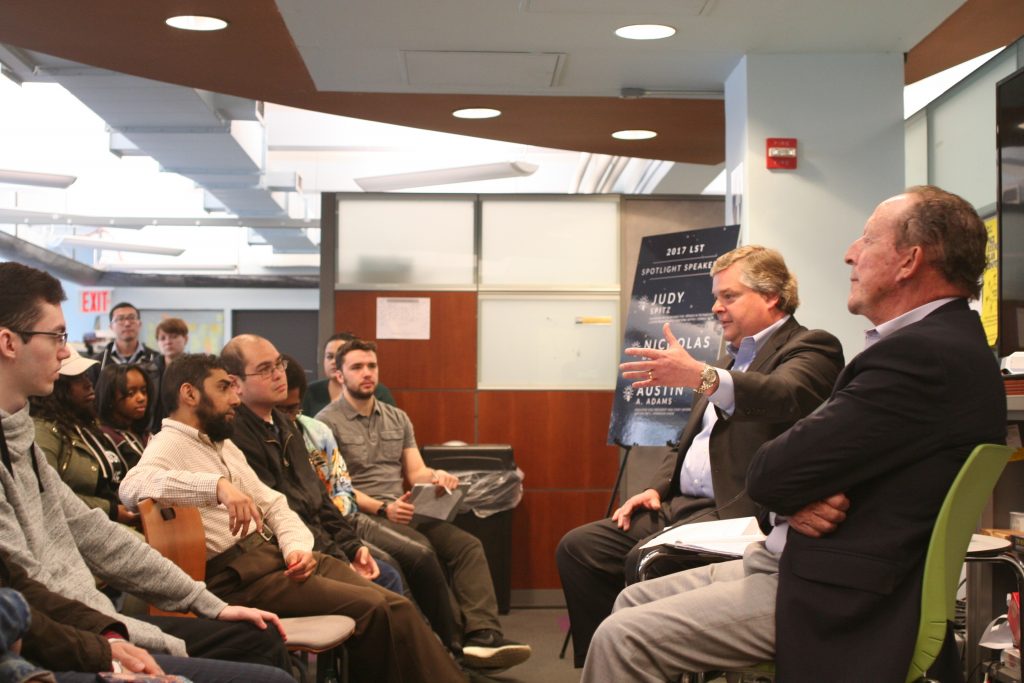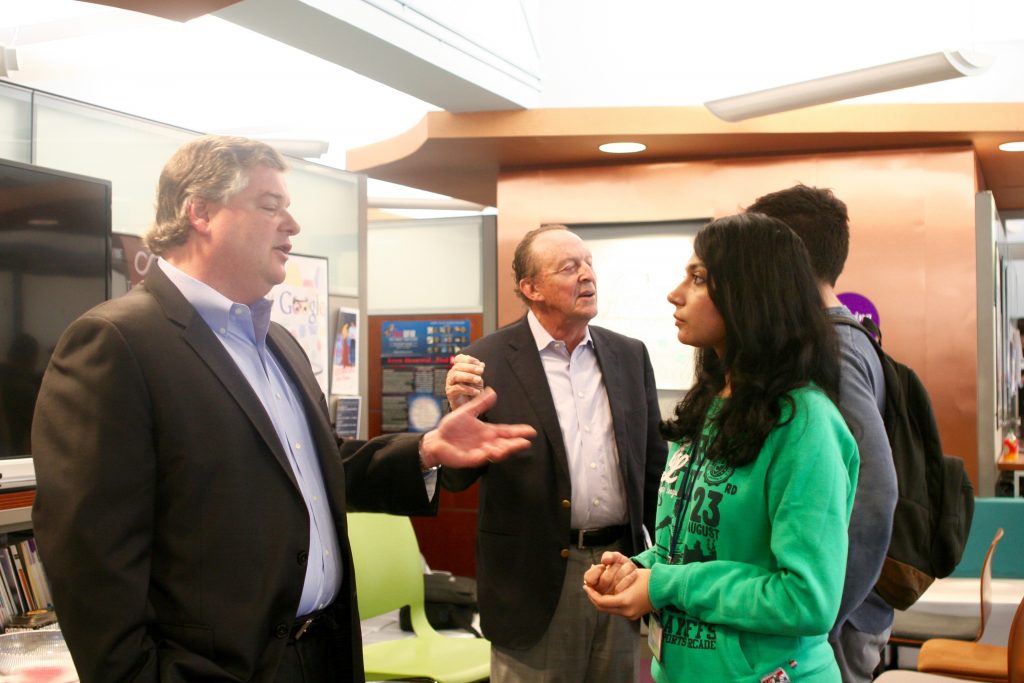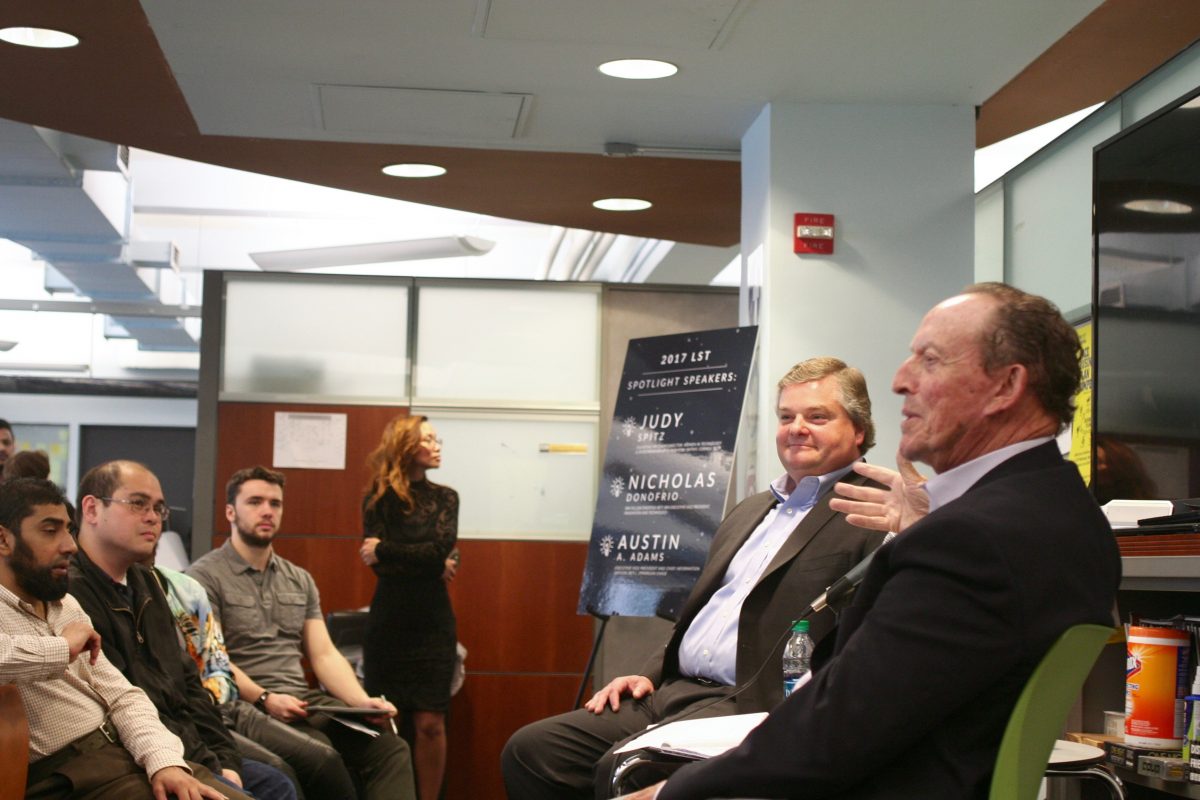The third and final of our LST Honoree Speaker Series – a chain of interviews with previous winners of our prestigious Leadership and Service in Technology award – took place on Wednesday April 19, 2017, and featured Pace University alumnus and Seidenberg advisory board member Mike Zbranak interviewing the incredibly charismatic Austin A. Adams.
Austin was recognized for his leadership and service in technology in 2006 at one of the highest-grossing iterations of our annual fundraisers in its history. We were delighted to welcome both Austin and Mike back through our doors and they were equally as happy to join us.
“We are capping what has been an absolutely stellar series on financial technology throughout the year,” said Dr. Jonathan Hill, Dean of the Seidenberg School. “We are in the presence of two legends in the financial technology industry. We are honored to have with us Mr Austin A. Adams and Mike Zbranak.”
Austin A. Adams retired in 2006 as Executive Vice President and Corporate Chief Information Officer at JPMorgan Chase where he was a member of the 13-person Operating Committee and managed 28,000 employees and a $7bn budget. Currently, Austin serves on the board of several companies, including Spectra Energy Corp., CommScope, and Keycorp. “I welcome the opportunity to be here,” Austin remarked. “I really like the model here, so when I was given the invitation to come here I welcomed it.”
Moderator of the discussion, Mike Zbranak is the Managing Director and Deputy Chief Information Officer of Chase Consumer & Community Banking at JPMorgan Chase.
In front of a room packed with students, staff and faculty, and other members of our Pace community, Austin said one of the things that is always music to our ears: “I think you’re in the right industry.”
He continued: “The IT role needs new minds, new thoughts, and I commend you for that.”
It was time for the discussion to get underway, which Mike kicked off by asking Austin what drew him into technology.
“There are several things you’ll never see on my resume,” Austin replied. “I was a failed college professor and a failed professional golfer. I got into technology almost by mistake. I was a senior manager in a bank and one group I managed was technology.”

It was through this exposure that Austin began to see how important technology was to a company. He now touts it as one of the most, if not the most, important departments in any business. The long-standing problem, however, has been that businesses still refuse to see IT departments as anything other than an unfortunate necessity, here to fix computers so the real work can get done.
“IT was the backroom – where you process things, keep your mouth shut, process reports for the next day. I wanted the business to look at us in IT and say ‘we’re partners’.”
He spoke about business orientation bias, which is what a business’ motivations are based on what it is trying to do, how it is trying to make money and serve its customers. Typically, technology does not factor very much into these plans. However, by understanding the business’ motivations, the technology department could start taking steps towards contributing meaningful work that would get it recognized as integral to a better business.
“I used to talk about our group as being partners of choice and leaders of change,” Austin said. “Being a leader of change, it’s really an art form.”
Referring to the students in the room, he said: “Technology and you as a tech pro have an opportunity to leader change. You may not get your name on it, or get your name recognized in the WST or within the company, but there is no job family in any company that I’m aware of that knows as much about the company as the IT department. You possess all the meaningful information in the company.
“Focusing on the business, understand where the business is going, and you’re a leader behind the scenes.”
Mike added: “When you’re in IT, you are the integrators of everything. When people are coming to you and talking about what they want, you get business knowledge that other people don’t have. You can become a change agent. I hire about 700 college grads a year into our training program and do touch points about what people are learning. I always want them to opine or put up suggestions about what’s going on. I’ve noticed that people fresh from school are open to adding suggestions than people 10 years in. I learn more from those sessions than I do from my whole team.”
The conversation continued towards different types of change, namely keeping up if not getting ahead in an ever-changing world. Mike spoke about his observations during the start of his career at JP Morgan.
“When I went to school here and started working at JP Morgan on Broad Street, there were 11 Money Center Banks. They dominated the financial landscape at the time. You weren’t allowed to bank across state lines. Out of those 11 banks that ran everything, only two are left. All the rest were taken over or absorbed into other banks. Austin, you engineer these massive bank acquisitions or mergers. I’m talking about programs, think about a project you have worked on, you’re talking thousands of people, you’re really betting the bank. How do you sell the board on that?”
Austin said: “People think about innovation as being too much like a buzzword. Meaningful innovation in a company is a lot of very small steps taken by a lot of people. A lot of it is about mindsets, and really good programming. If you have any kind of skill set in the world of program management, there will be a need forever for people who can coordinate between areas in business. Really good technology people look at what the business opportunity is and they can make it happen. Thinking about innovation, think about your position as an IT professional to make those small steps.”
Much of innovation can be found in consolidation. Mike spoke at length about his experiences coming into businesses and finding far too many processes, programs, and options when just a few would suffice. At JP Morgan, the business was so customer-focused that there were 970 services when Mike took over – Amex had three. When Mike asked his new team what they could reduce their services by and nobody responded, he told them “we’re going to have 10.” By consolidating hundreds of services into just 10, the business began to operate far more smoothly.
Austin agreed, saying that the biggest missed opportunity he’d had at JP Morgan was that the technology team failed to communicate the cost of complexity, or the value of simplicity. “You’ll see complexity in organizations that really doesn’t need to be there unless someone’s willing to make tough discussions. If you have a simpler environment and one way of doing something, you can increase your productivity and your profit.”
Innovation can be looked at as efficiency; it adds effectiveness. Innovation can be a life-changing moment, but it’s also incremental because it’s made up of small improvements. For example, Craigslist was an innovative site when it was created, but then people took what Craigslist was offering – goods and services – and made apps from it. Uber exists as a combination of existing taxi businesses and the ordering online concept.
“At some time in your career, you’re going to see pieces of information that’s going to show that something needs to be done better,” Austin said.
Mike agree, adding that the need to move quickly can be a challenge in traditionally slow moving business. “I think about how fast opportunity comes and go. I take my phone and look up the mobile app for Chase. We have a digital wallet now – I was talking about it nine years ago. After years of meetings and mergers, we didn’t talk about it enough – then Apple came and ate our lunch. Then, instead of being something innovative, it becomes something you have to have because everybody else has it.”
Austin and Mike then discussed the importance of having trained cybersecurity professionals entering the fintech space. “The one thing any board is worrying about is cyber,” Austin said. “Five of six panels (at a conference) ended up talking about cybersecurity. Four were scared to death because they don’t know what to do about it.”
Finally, Austin shared three things he has observed over the last few decades in his guide for how to accelerate your career. Here are his three opportunities:
- Peer feedback. Work in any company, and your boss only has so much time to give you feedback. If you quickly get your head around creating dialog with a peer of yours so you can say “Jack, I want to succeed and I want the company to succeed; I’d like to get constructive criticism from you. I’ll buy you a beer every few weeks if you’ll sit down with me and give me feedback. Most people won’t do it, but some will and you’ll get extraordinary feedback. We are never in reality the way we see ourselves. Getting that outside perspective is crucial.
- You’re going to work with people who have skills and knowledge that you want to develop. Mike is one of the best technologists I know, but when he was new to a senior CI role he worked on developing his skill. If you go to people who have the skills you want to develop and ask for 15 minutes for them to explain how they got to where they are, most will say yes. This is a real way to accelerate your learning process.
- Think hard about what an extra hour a week would do for you if you spent it learning about the company. It may be more fun to spend the time at leisure, but if you spend an hour or so spending your discretionary time learning about your profession and the business it will help you get so far.

Mike Zbranak and Austin A. Adams chat with Seidenberg students
After the discussion between Mike and Austin, there was a brief Q&A session followed by time for the students to chat with our guests in person. We’d like to extend a massive thank you to Mike Zbranak and Austin A. Adams for taking the time to visit us and look forward to seeing you at the LST Awards and in the future!
Previous speakers:


